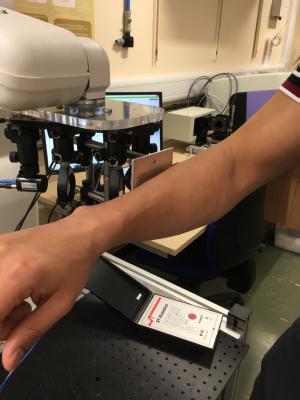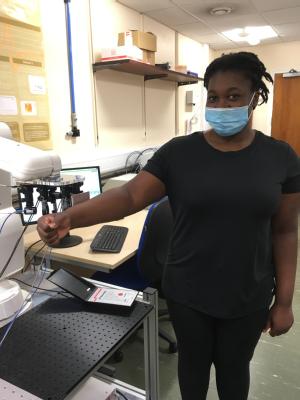Robots with T-ray technology to spot and remove cancer tumours in £8 million project
- Scientists to investigate potential of terahertz radiation, or T-rays, to diagnose skin and colorectal cancers and improve accuracy of cancer surgery using robots
- £8 million funding for collaboration led by University of Warwick and involving University Hospitals of Coventry and Warwickshire, University of Leeds and University of Exeter
- T-ray probe technology to be combined with medical-grade surgical robots
- There are over 150,000 cases of new cases of skin cancer in the UK each year, while 1 in 15 UK males and 1 in 18 UK females will be diagnosed with bowel cancer in their lifetime and it is the second most common cause of cancer death in the UK
- Photographs available in Notes to Editors
 New technology that will marry probes that can detect cancer tumours through the skin with high-precision robotic surgery is to be developed for use in hospital settings for the first time in a project led by the University of Warwick.
New technology that will marry probes that can detect cancer tumours through the skin with high-precision robotic surgery is to be developed for use in hospital settings for the first time in a project led by the University of Warwick.
The Terabotics project will use probes that use terahertz radiation, or T-rays, to scan for tumours under the skin while medical-grade surgical robots will be adapted to use these scans to guide them in removing tumours in skin and colorectal cancer patients more precisely.
If successful, the researchers hope it could lead to real-time diagnosis for cancer patients, shorter waiting periods for cancer surgery, and more comprehensive removal of tumours with reduced need for follow-up surgery.
The project, which has received funding of £8 million from the Engineering and Physical Sciences Research Council, part of UK Research and Innovation, is a collaboration between the University of Warwick, University Hospitals of Coventry and Warwickshire, University of Leeds and the University of Exeter. The five-year project starting in September 2021 aims to eventually trial the technology with patients attending cancer services at University Hospitals Coventry and Warwickshire and Leeds Teaching Hospitals NHS Trust.
Terabotics will use research from the University of Warwick into terahertz (THz) radiation, or T-rays, which sit in-between infrared and WiFi on the electromagnetic spectrum. Previous work from the University of Warwick’s Department of Physics has shown that these can be used to detect very subtle changes in the outermost layers of skin, and the technique has already been demonstrated on healthy volunteers. This will be the first time that it will be studied in patients within an active cancer process.
As well as assessing how effective T-ray technology is in diagnosing cancers compared to standard care, the project aims to incorporate the technology into surgical robots to guide them more accurately when detecting tumours during colonoscopy and removing them during surgery.
 Principal Investigator Professor Emma Pickwell-MacPherson (pictured, left), from the University of Warwick Department of Physics, said: “What we will be testing is our hypothesis that we are able to detect a buried or hidden tumour. We think our terahertz probe will be able to detect those through looking at the transient response of the skin.
Principal Investigator Professor Emma Pickwell-MacPherson (pictured, left), from the University of Warwick Department of Physics, said: “What we will be testing is our hypothesis that we are able to detect a buried or hidden tumour. We think our terahertz probe will be able to detect those through looking at the transient response of the skin.
“Somebody might already be diagnosed with cancer but the actual extent of that cancer may not be known. For example, in skin cancer patients, the THz probe will image the visible tumour and the surrounding area to better determine the extent of the tumour that is beneath the surface. This will enable the whole tumour to be removed in one go, rather than incrementally. In turn, this enables better planning for reconstruction and speeds up the procedure.”
Initially, the researchers will focus on adapting the T-ray probes to work with the surgical robots, miniaturisation of the technology and refining the design to provide more diagnostic parameters.
Later stages of the project will involve trialling the technology with patients with a known or suspected cancer. Those attending cancer services at University Hospitals Coventry and Warwickshire will be offered the opportunity to participate alongside their routine care. Colorectal cancer patients will be seen at the University of Leeds, where an endoscopic probe is being developed specifically to examine the colon. Just like our skin, the colon is an epithelial lining and could potentially be scanned by T-rays in the same way.
 At present, diagnosis of skin cancer relies upon a visual inspection by a clinician and a biopsy. There are over 150,000 new cases of skin cancer in the UK each year (1) and two to three million globally (2), numbers which are set to rise due to increased life expectancy. 1 in 15 UK males and 1 in 18 UK females will be diagnosed with bowel cancer in their lifetime and it is the second most common cause of cancer death in the UK. (2)
At present, diagnosis of skin cancer relies upon a visual inspection by a clinician and a biopsy. There are over 150,000 new cases of skin cancer in the UK each year (1) and two to three million globally (2), numbers which are set to rise due to increased life expectancy. 1 in 15 UK males and 1 in 18 UK females will be diagnosed with bowel cancer in their lifetime and it is the second most common cause of cancer death in the UK. (2)
Professor Joseph Hardwicke, Medical Lead for the project at University Hospitals of Coventry and Warwickshire, said: “This technique is a way to examine the skin at a deeper and more technical level than what we are able to at the moment. The main hope, especially for skin cancer, is to determine the extent of the spread locally and also to potentially diagnose these cancers without the need for a biopsy in future.
“This is a whole new area of diagnostics, like how MRI in the 1980s revolutionised medical imaging. I think this is a chance for terahertz combined with robotics to give us that greater accuracy. Even though we are still building evidence, there seems to be a lot of pieces of the jigsaw that make logical sense.”
Professor Pickwell-MacPherson adds: “If we can give a quantitative answer using our technology that would be great, and ultimately that will speed up the throughput of patients. That in turn will reduce waiting times and costs, it will mean that the surgical procedures can be better planned and done more efficiently, the number of follow-up procedures can be reduced, then that has implications financially to the NHS.
"This area is up and coming and terahertz robotics is becoming a hot topic. It has long been suggested that THz technology could be used for cancer detection and this project will push the technology forward to make it a reality. We hope that by demonstrating its application to skin and colon cancers we will open up the door to applying the technology to benefit other cancers too and transform cancer treatment protocols.”
Professor Pietro Valdastri of the University of Leeds said: “Robotics is increasingly used in the operating theatre as it brings superior accuracy and unload some of the burden of the procedure from the surgeon. At Leeds, we are developing the next generation of surgical robots to detect colorectal cancer earlier and remove it more effectively. Adding THz perception capabilities to our robots is a new exciting avenue of research that has the potential to improve cancer patient quality of life in the next 5 to 10 years.”
The project is among 20 innovative projects announced to revolutionise healthcare, improve treatments for millions of people with a wide range of conditions and save the NHS money.
The projects are supported by £30.8 million of funding by the Engineering and Physical Sciences Research Council (EPSRC), part of UK Research and Innovation (UKRI). Four projects were co-funded by UKRI’s Medical Research Council (MRC).
EPSRC Executive Chair Professor Dame Lynn Gladden said:
“Technologies and approaches pioneered by UK researchers have the potential to revolutionise treatment for a wide range of conditions, from bowel cancer to diabetes.
“The projects announced today exemplify this potential and may play a key role in improving the lives of millions of people.”
Ends
Notes to editors:
- https://www.cancerresearchuk.org/about-cancer/skin-cancer/about-skin-cancer
- https://www.who.int/news-room/q-a-detail/radiation-ultraviolet-(uv)-radiation-and-skin-cancer
- https://www.cancerresearchuk.org/health-professional/cancer-statistics-for-the-uk
Photographs available to download - The in vivo THz imaging systems set up for skin imaging in Professor Emma MacPherson's lab at the University of Warwick:
https://warwick.ac.uk/services/communications/medialibrary/images/may_2021/img_2920.jpeg (pictured: Professor Emma MacPherson)
https://warwick.ac.uk/services/communications/medialibrary/images/may_2021/img_2946.jpeg
https://warwick.ac.uk/services/communications/medialibrary/images/may_2021/img_2947.jpeg
https://warwick.ac.uk/services/communications/medialibrary/images/may_2021/img_2943.jpeg
https://warwick.ac.uk/services/communications/medialibrary/images/may_2021/img_2931.jpeg
https://warwick.ac.uk/services/communications/medialibrary/images/may_2021/img_2902.jpeg
5 June 2021
University of Warwick press office contact:
Peter Thorley
Media Relations Manager (Warwick Medical School and Department of Physics) | Press & Media Relations | University of Warwick
Email: peter.thorley@warwick.ac.uk
Mob: +44 (0) 7824 540863
Note for patients: Patients will be invited to participate after referral via GP on a suspected cancer referral. There are no plans for open recruitment to this study at this time.
